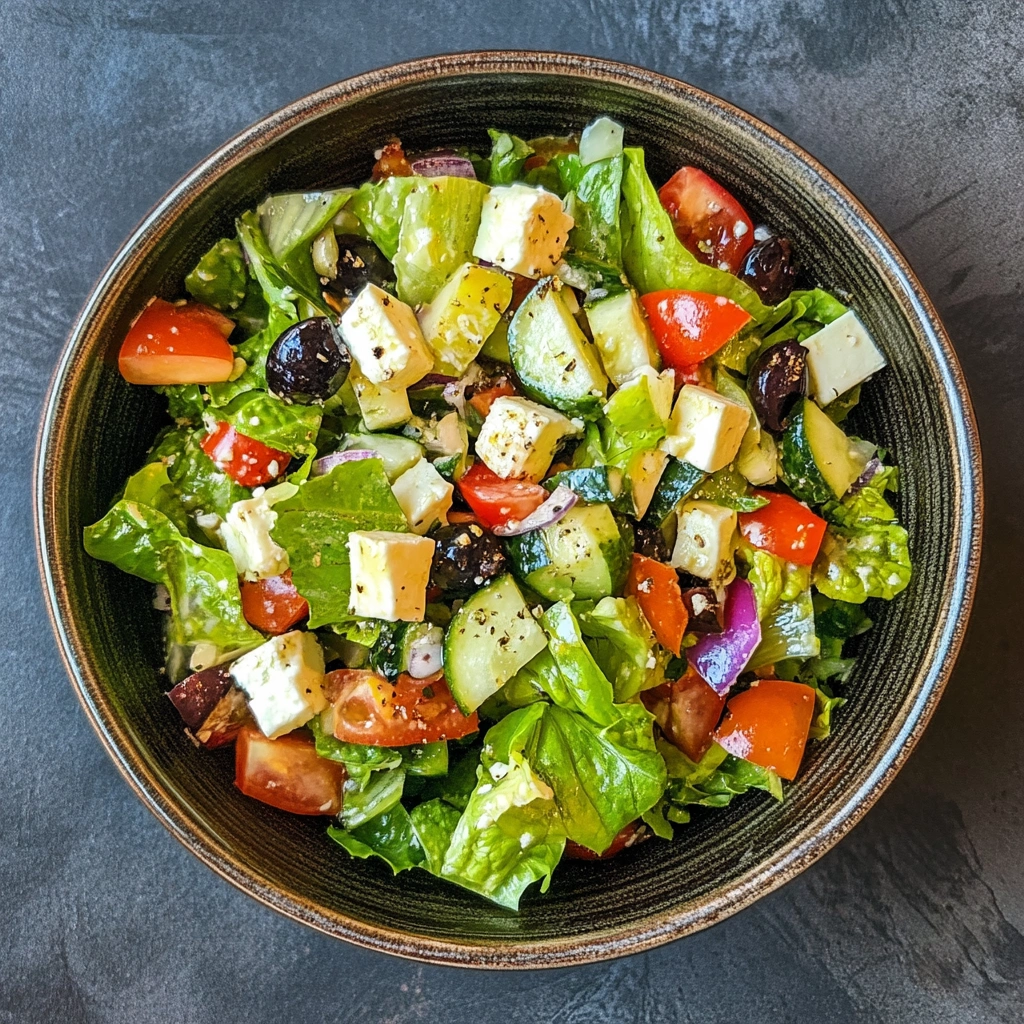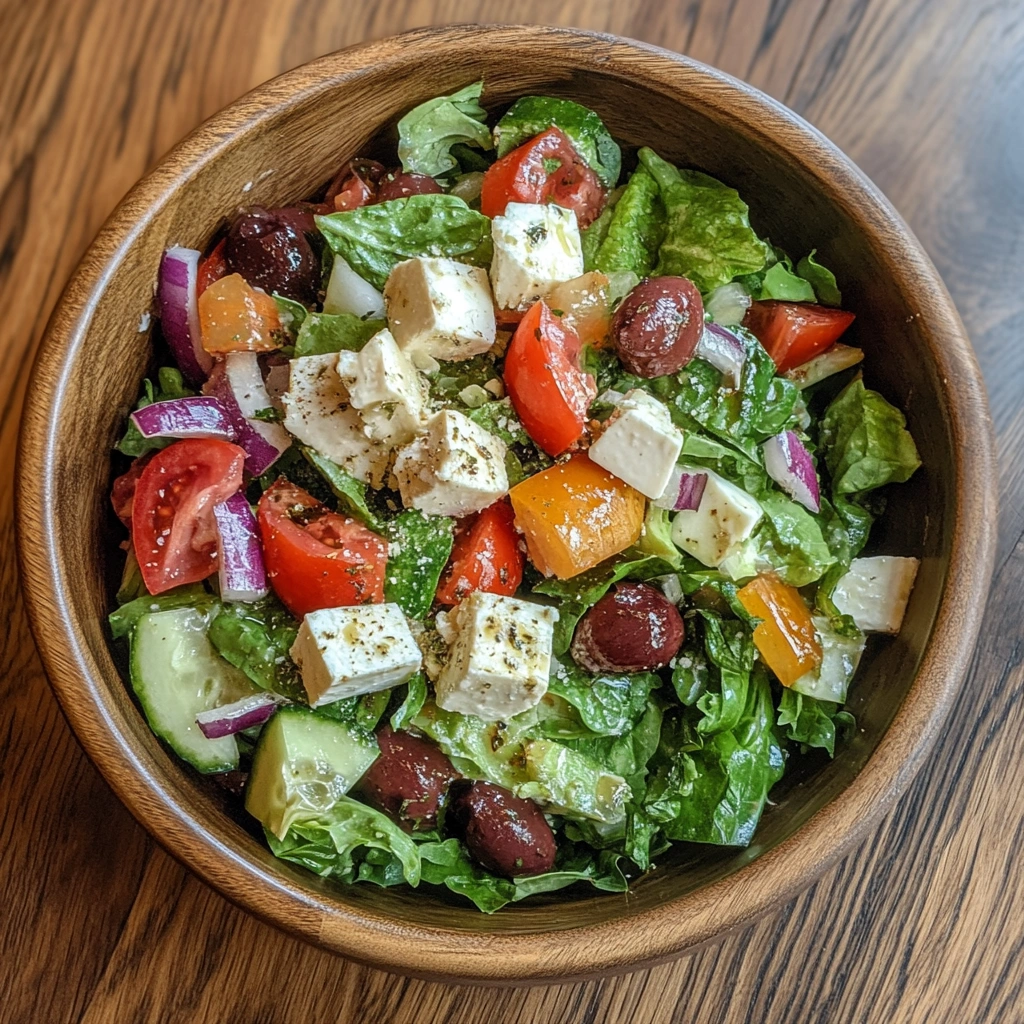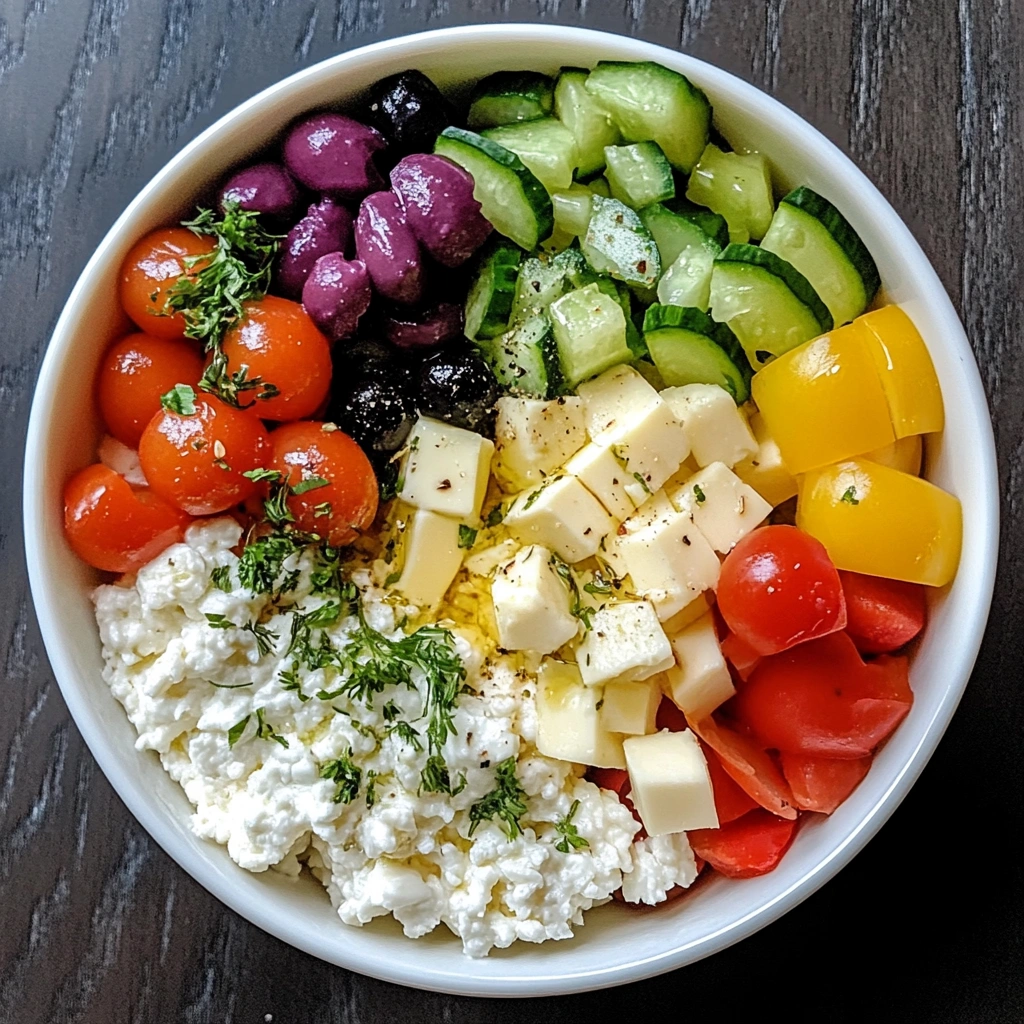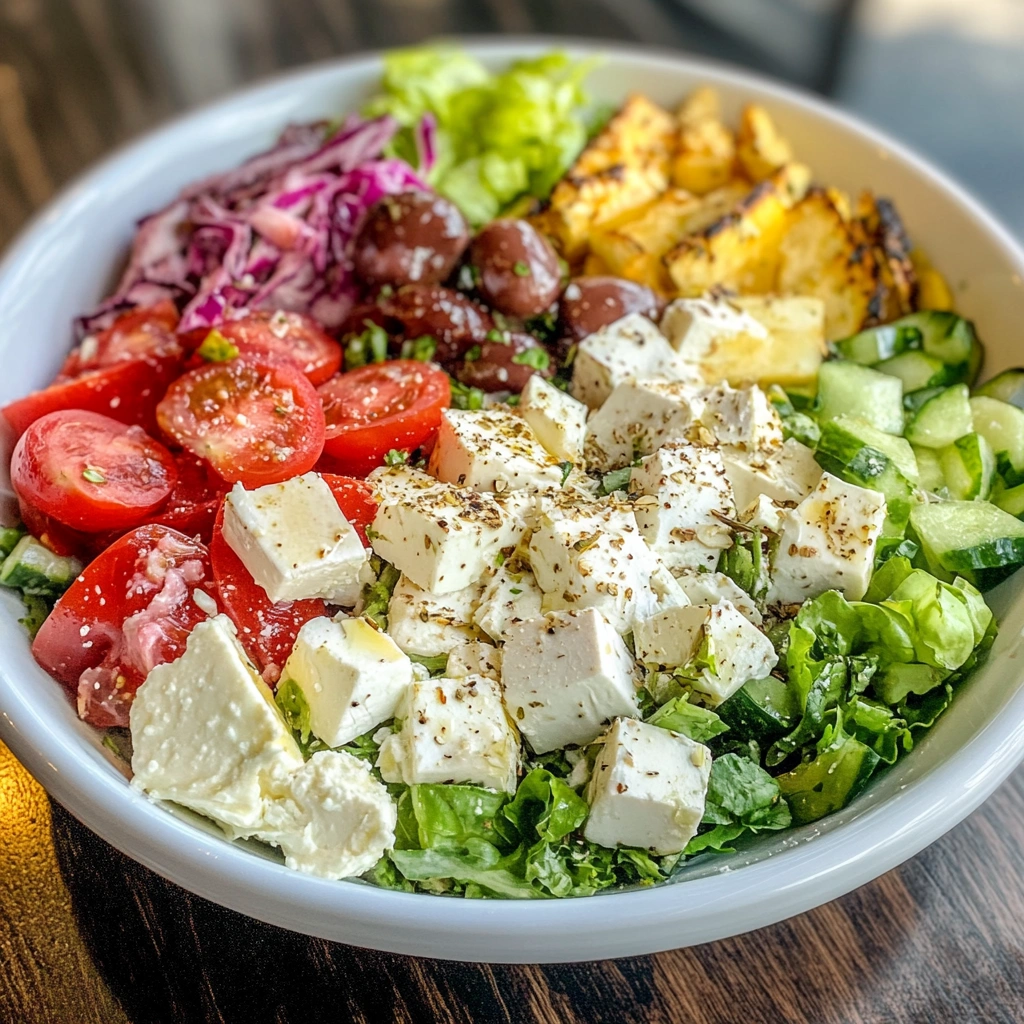Every summer, my family looks forward to the Greek salad. It’s more than food; it’s a way to share memories. The mix of crisp veggies, tangy feta, and olive oil brings us joy.
A vibrant Greek salad elegantly arranged in a rustic bowl, featuring ripe tomatoes, crisp cucumbers, red onions, green bell peppers, black olives, and creamy feta cheese. Drizzled with golden olive oil and sprinkled with oregano, set against a backdrop of a sunlit Mediterranean kitchen. Fresh herbs and lemon wedges nearby for garnish.
The Greek salad is a masterpiece of the Mediterranean diet. It’s not just a side dish. It’s a celebration of fresh ingredients that make us feel good.
This salad is full of nutrients and flavor. It shows how food, health, and happiness are connected. Let’s explore this iconic dish that has won hearts around the world.
Key Takeaways
- Greek salad is a nutritious cornerstone of the Mediterranean diet
- Fresh, high-quality ingredients are crucial for an authentic experience
- The salad offers both incredible taste and significant health benefits
- Simple preparation makes it accessible to home cooks of all skill levels
- Each bite connects you to rich Mediterranean culinary traditions
The History and Origins of Traditional Greek Salad
The Greek salad is a key part of the Mediterranean diet, with a history that goes back centuries. It comes from Greece, where fresh ingredients are highly valued.
A rustic Greek farm setting with vibrant fields of tomatoes, cucumbers, and bell peppers, traditional Mediterranean architecture in the background, olive trees lining the path, a wooden table set with a traditional Greek salad featuring feta cheese and Kalamata olives, sun-drenched atmosphere capturing the essence of Greek culture and cuisine.
Learning about the Greek salad’s history is more than just a recipe. It’s a story of cultural strength and new ideas in cooking. Each ingredient adds a piece to Greece’s food story.
Origins in Mediterranean Culture
The Mediterranean diet gave birth to the Greek salad. It’s a simple dish that shows the beauty of local food. Farmers and shepherds made it with ingredients they had:
- Ripe tomatoes from sun-drenched fields
- Crisp cucumbers
- Pungent onions
- Briny Kalamata olives
- Creamy feta cheese
Evolution Through Generations
Over time, the Greek salad changed. What started as a simple meal became famous worldwide. Different areas in Greece added their own twist, making it unique everywhere.
| Region | Unique Ingredient | Characteristic |
|---|---|---|
| Crete | Purslane | Adds earthy flavor |
| Thessaly | Green peppers | Increases crunch |
| Cyclades | Capers | Enhances saltiness |
Regional Variations
Every Greek region put its own spin on the classic Greek salad. The place where food is grown, or terroir, helped shape these local versions.
Essential Ingredients for an Authentic Greek Salad

A vibrant arrangement of fresh Greek salad ingredients, featuring ripe tomatoes, crisp cucumbers, red onions, green bell peppers, Kalamata olives, and creamy feta cheese, all elegantly placed on a rustic wooden table, with a drizzle of olive oil and a sprinkle of oregano for added flavor.
To make a real Greek salad, start with the best ingredients. Choose fresh, top-quality veggies and traditional items. They add vibrant flavors to every bite.
The base of a classic Greek salad is ripe tomatoes and crisp cucumbers. These veggies add color and freshness. Cut tomatoes into chunky wedges and cucumbers into thick rounds for the traditional look.
- Tomatoes: Choose vine-ripened, deep red tomatoes with rich flavor
- Cucumbers: Select firm, dark green English or Persian cucumbers
- Red onions: Thinly slice for a sharp, pungent taste
- Feta cheese: Use authentic Greek white cheese
- Kalamata olives: Select premium, deep purple olives
Feta cheese is key to a Greek salad. Choose Greek feta made from sheep’s or goat’s milk for the best taste. Crumble the cheese in big chunks over your salad.
| Ingredient | Selection Tip | Ideal Quantity |
|---|---|---|
| Tomatoes | Ripe, deep red color | 2-3 medium tomatoes |
| Cucumbers | Firm, dark green | 1 large cucumber |
| Red Onions | Mild, not overpowering | 1/2 medium onion |
| Feta Cheese | Authentic Greek style | 100-150 grams |
| Kalamata Olives | Imported from Greece | 10-15 olives |
Kalamata olives top off your Greek salad. These rich, meaty olives add a unique briny taste. Pick olives that are plump, glossy, and deep purple-black for the best taste.
The secret to a great Greek salad is using the freshest ingredients and following traditional ways. Your hard work will show in every delicious bite.
Why Greek Salad is the Perfect Mediterranean Diet Staple
Greek salad is a nutritional powerhouse in the Mediterranean diet. It offers a delicious way to improve your health. This dish is more than a simple salad. It’s a mix of nutrients that changes how you eat.
The Mediterranean diet is known for its health benefits. Olive oil is a key part of it. Greek salad captures the diet’s essence with fresh veggies, olive oil, and other nutrients.
Nutritional Benefits
- Rich in antioxidants from fresh vegetables
- Provides essential vitamins and minerals
- Low in calories, high in nutritional value
Mediterranean Diet Principles
The Mediterranean diet focuses on whole, unprocessed foods. Greek salad follows this principle with its simple yet effective ingredients.
| Ingredient | Nutritional Benefit |
|---|---|
| Tomatoes | High in lycopene, supports heart health |
| Olive Oil | Contains healthy monounsaturated fats |
| Cucumbers | Hydrating and low in calories |
| Feta Cheese | Provides calcium and protein |
Health-Boosting Properties
Greek salad’s fresh ingredients offer amazing health benefits. Olive oil is key, with its anti-inflammatory effects and heart health support. This salad can lower disease risks and boost overall wellness.
Adding Greek salad to your meals is more than just eating well. It’s adopting a lifestyle of healthy, whole-food eating. This can greatly improve your health from the inside out.
Selecting and Preparing Fresh Vegetables for Your Greek Salad
Making a great Greek salad begins with picking the best vegetables. The quality of your tomatoes, cucumbers, and red onions is key. They can make or break this classic dish from the Mediterranean.
Vegetable Selection Guide
- Tomatoes: Choose ripe, bright red tomatoes. They should have a deep color and be firm. Vine-ripened or heirloom tomatoes are the best for a true Greek salad.
- Cucumbers: Pick dark green cucumbers that are crisp. Avoid those with soft spots. English or Persian cucumbers are great for their crunch and few seeds.
- Red Onions: Go for firm red onions with a vibrant purple-red skin. Smaller onions are sweeter and better for salads.
Preparation Techniques
Washing and cutting your vegetables right is important. Rinse them well under cool water. Then, dry them with clean towels to get rid of extra moisture.
| Vegetable | Cutting Technique | Recommended Size |
|---|---|---|
| Tomatoes | Wedge or chunk cut | 1-inch pieces |
| Cucumbers | Half-moon slice | 1/4-inch thick |
| Red Onions | Thin rings or half-moon slice | 1/8-inch thick |
Keep your cut vegetables in an airtight container in the fridge. Use them within 24 hours for the best taste and texture in your Greek salad.
The Art of Choosing Quality Feta Cheese and Kalamata Olives

Making a real Greek salad starts with picking the right ingredients. Feta cheese and kalamata olives are more than just toppings. They are the heart of the salad, giving it its taste and character.
Selecting Premium Feta Cheese
Here’s what to look for in feta cheese:
- Creamy white color with a crumbly texture
- Tangy, sharp flavor that’s true to Greek feta
- Protected Designation of Origin (PDO) from Greece
Identifying Top-Quality Kalamata Olives
Kalamata olives are key for a real Greek salad. Look for these traits:
- Deep purple to black color
- Smooth, almond-like shape
- Rich, buttery taste with a hint of saltiness
Proper Storage Techniques
Keep your feta cheese and kalamata olives fresh with these tips:
| Ingredient | Storage Method | Shelf Life |
|---|---|---|
| Feta Cheese | Refrigerate in brine or olive oil | 1-2 weeks |
| Kalamata Olives | Keep in sealed container with brine | 2-3 weeks |
Choosing the best feta cheese and kalamata olives makes your Greek salad stand out. Freshness and authenticity are what bring the Mediterranean to life in your dish.
Creating the Perfect Greek Salad Dressing with Olive Oil
Making the perfect Greek salad dressing is all about precision and quality. The key ingredient is premium olive oil. It adds depth and richness to every bite.
Choosing the right olive oil is essential. Look for extra virgin olive oil with a strong flavor. It should match well with fresh vegetables. The best oils come from the Mediterranean, offering a smooth, peppery taste.
- Choose cold-pressed extra virgin olive oil
- Select oils from Greece or Italy for authentic taste
- Check harvest dates for freshness
Your dressing needs balance. Greek recipes often use red wine vinegar. It adds a tangy contrast to the olive oil’s richness. Aim for a ratio of three parts olive oil to one part vinegar.
| Ingredient | Quantity | Purpose |
|---|---|---|
| Extra Virgin Olive Oil | 3 parts | Base and flavor foundation |
| Red Wine Vinegar | 1 part | Adds brightness and acidity |
| Dried Oregano | 1 tsp | Provides Mediterranean herb essence |
| Salt | To taste | Enhances overall flavor |
Pro tip: Whisk your ingredients well or use a small jar with a tight lid. This helps mix the olive oil and vinegar smoothly. It ensures the dressing coats each salad ingredient perfectly.
Tips and Techniques for Assembling Your Greek Salad
Making a perfect Greek salad is an art. It needs fresh ingredients, precise techniques, and great presentation. Whether you’re cooking at home or love to cook, learning how to assemble this classic dish will make your salad stand out.
Precise Cutting Techniques
Cutting vegetables for your Greek salad is important. It requires skill and attention to detail. Here are some tips to get the best texture and flavor:
- Cucumbers: Slice into uniform quarter-inch thick half-moons
- Tomatoes: Cut into bite-sized wedges or chunks
- Red onions: Slice thinly for a delicate, sharp flavor
- Bell peppers: Dice into consistent small squares
Strategic Layering Methods
Layering your Greek salad is key. Start with crisp vegetables at the bottom. Then add softer ingredients like feta cheese and olives on top. This keeps vegetables crisp and ensures each bite is balanced.
Presentation Tips
Make your Greek salad look amazing with these tips:
- Use a wide, shallow bowl to showcase ingredients
- Crumble feta cheese generously on top
- Drizzle extra virgin olive oil in an artistic pattern
- Garnish with fresh oregano leaves
By following these tips, you’ll make a stunning Greek salad. It will be delicious and look great. Remember, seeing is believing, and your salad should be a feast for the eyes!
Common Mistakes to Avoid When Making Greek Salad

Making the perfect Greek salad needs focus and knowing the right techniques. Many people make mistakes that ruin the dish’s true taste and texture. This is a classic Mediterranean favorite.
Let’s look at the most common mistakes in making a Greek salad:
- Overdressing the Salad: Too much dressing can hide the fresh vegetable flavors. Just a little olive oil and vinegar is enough.
- Choosing Low-Quality Ingredients: Your salad’s quality depends on its ingredients. Pick ripe tomatoes, crisp cucumbers, and real feta cheese.
- Incorrect Cheese Selection: Not all feta is the same. Choose traditional Greek feta made from sheep’s or goat’s milk for the best taste.
When you make your Greek salad, remember these important tips:
- Use fresh, seasonal vegetables
- Slice ingredients to uniform sizes
- Season sparingly with salt and oregano
- Allow the salad to rest briefly before serving
Temperature and how you prepare ingredients matter a lot. Serve your salad a bit chilled. Chop vegetables just before mixing to keep them fresh and crisp.
By avoiding these common mistakes, you’ll make your Greek salad amazing. It will truly show off the flavors of Mediterranean cuisine.
Seasonal Variations and Modern Twists on Greek Salad
Your Greek salad doesn’t have to stick to the old recipe. It’s a versatile dish that can change with the seasons. This keeps it exciting and fresh.
The Greek salad is very adaptable. Each season brings new fruits and veggies. These can turn the classic salad into something amazing.
Summer Produce Transformations
In summer, your Greek salad can burst with color and flavor. Try adding these fresh ingredients:
- Grilled summer squash
- Fresh corn kernels
- Ripe watermelon cubes
- Heirloom tomato varieties
Creative Mediterranean Diet Adaptations
Modern cooking has brought new ideas to the Greek salad. Mix in unique ingredients while keeping the Mediterranean diet’s essence.
| Adaptation Style | Key Ingredients |
|---|---|
| Protein-Packed Version | Grilled chicken, quinoa |
| Vegan Twist | Roasted tofu, nutritional yeast |
| Seafood Variation | Grilled shrimp, lemon zest |
Serving Suggestions
Your Greek salad can be a hit in many ways. Serve it as a light lunch, elegant appetizer, or refreshing side dish. The secret is to keep the flavors bright and fresh.
- Picnic centerpiece
- Dinner party starter
- Quick weeknight meal
Conclusion
Your journey into Greek salad shows it’s more than just ingredients. It’s a mix of fresh veggies, tangy feta, and strong olive oil. This combo makes a meal that’s both healthy and tasty.
The Greek salad is more than a recipe. It’s a way to connect with Mediterranean traditions. Making an authentic Greek salad means you’re choosing a healthier, more flavorful way of eating.
Whether you’re an experienced cook or just starting, making your own Greek salad is exciting. Try new veggies, different olives, and your own dressing. The Greek salad is all about being flexible and staying true to your taste while being healthy.
Begin your Mediterranean diet adventure with Greek salad. Your body will love the nutrients, and your taste buds will enjoy the fresh flavors. Every bite is a treat.
Free Body Calculator – Know Your Body
Wondering if your body is in a healthy range? Use our Free Body Calculator to find out if you’re fit, normal, or need a lifestyle change. Get personalized tips, calorie targets, and your ideal protein, carbs, and fat intake – all in seconds.
Try Free Body Calculator Now
Easy Greek Salad with Feta, Olives, and Homemade Dressing
Ingredients
- For the Salad:
- 1 large cucumber chopped
- 1 1/2 cups cherry tomatoes halved
- 1/2 red onion thinly sliced
- 1/2 cup Kalamata olives pitted and halved
- 1/2 cup feta cheese crumbled or cubed
- 1/4 cup fresh parsley chopped
- For the Dressing:
- 3 tbsp olive oil
- 1 tbsp red wine vinegar
- 1 tsp lemon juice
- 1/2 tsp dried oregano
- 1/2 tsp Dijon mustard optional, for extra tang
- 1 clove garlic minced
- Salt and black pepper to taste
Instructions
- Prepare the Dressing:
- In a small bowl, whisk together olive oil, red wine vinegar, lemon juice, oregano, Dijon mustard, garlic, salt, and black pepper. Set aside.
- Assemble the Salad:
- In a large bowl, combine cucumbers, tomatoes, red onion, Kalamata olives, and feta cheese.
- Toss and Serve:
- Drizzle the dressing over the salad and toss gently to coat.
- Garnish with fresh parsley and serve immediately.
Notes
- Make It a Meal: Add grilled chicken, shrimp, or chickpeas for extra protein.
- Storage: Store in an airtight container in the fridge for up to 2 days. Add dressing just before serving to keep it fresh.
- Customize: Try adding bell peppers or capers for extra flavor.


1 thought on “Easy Greek Salad with Feta, Olives, and Homemade Dressing”
Comments are closed.